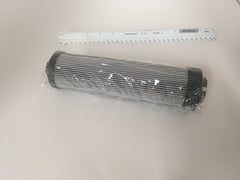Filters
Hydraulic Filtration and Contamination
All hydraulic systems have a common need for protection from harmful contaminants. Contamination control means effective filtration. Filtering particles large enough to be harmful to your system prevents damage and allows the longest possible filter service life. Maintenance costs can be minimized through contamination control practices and proper filter application (refer to your manufacturers recommendations for your particular application).
Contaminants, the natural enemy of hydraulic systems, cause the majority of all failures. If not controlled, even particles too small to be seen can reduce hydraulic system efficiency. System efficiencies may be significantly reduced before a problem is recognized. Contamination affects hydraulic systems in many ways.
-
Corrosion of hydraulic systems from acids that form due to fluid breakdown and mixing of incompatible fluids in the system
-
Increased internal leakage which lowers the efficiency of pumps, motors, and cylinders. It decreases the ability of valves to control flow and pressure accurately. It also wastes horsepower and generates excess heat.
-
Sticking of parts due to sludge or silting. Silting is a collection of fine particles in critical areas, which will impair proper system operation.
-
Seizure of parts or components caused by large amounts of contaminants getting stuck in the clearances.
There are several major sources for system contamination.
-
Contamination present at the point of manufacture
-
Replacement hydraulic fluid contamination
-
Environmental contamination
-
System wear contamination
-
Contamination introduced during the servicing process
Built-in contamination, or primary contamination, is caused during the manufacture, assembly and testing of the hydraulic components. Metal filings, small burrs, pieces of thread sealing tape (other sealing compounds), sand and
Revised April 2008 Page 1 of 3
-
other contaminants are routinely found in initial clean up filtration of newly manufactured systems. These can be the most damaging particles to your system. Using a filter based on the manufacturers recommended filtration rating can prevent early catastrophic system failure.
Replacement hydraulic fluid is often contaminated to a level that may be higher than acceptable for most hydraulic systems. Some manufacturers address this issue by filtering hydraulic fluid prior to system filling or just "topping-off" a system. Check the hydraulic fluid to be sure it meets the latest ISO codes for the system in which it will operate.
Contamination can enter the hydraulic system fluid supply through quick couplings, rod seals, breather caps, worn cylinder rods and by other means.
The internal operation of the system generates contaminates that need to be removed. Internal components can generate minute particles that will contaminate a hydraulic system.
When systems are checked or disassembled for inspection or repair, the system is vulnerable to dust and air borne contaminates. These contaminates can adhere to filler caps, breathers, funnels, transfer pumps and replacement parts. Care must be taken during all repairs to keep the system free from contaminates.
In order to work on hydraulic systems properly and safely, you should:
-
Clean exterior surfaces of dust, dirt, oil, etc. before removing covers
-
Make sure new parts are clean
-
Use a vigorous wash when cleaning parts
-
Keep parts protected prior to assembly
-
Protect system openings use covers, tape, plastic wrap, etc.
-
Clean transfer containers, funnels, nozzles, etc.
-
Use covers to protect drums from becoming dirty or wet around their lids
-
Filter fluids before filling sumps, don't remove filler screens
-
Clean filters for all hydraulic fluid handling
-
Use clean-out filters to clean system after assembly
Filter Hydraulic High Pressure H&L
Replaces Strippit® part number 4219007-3
42190073
